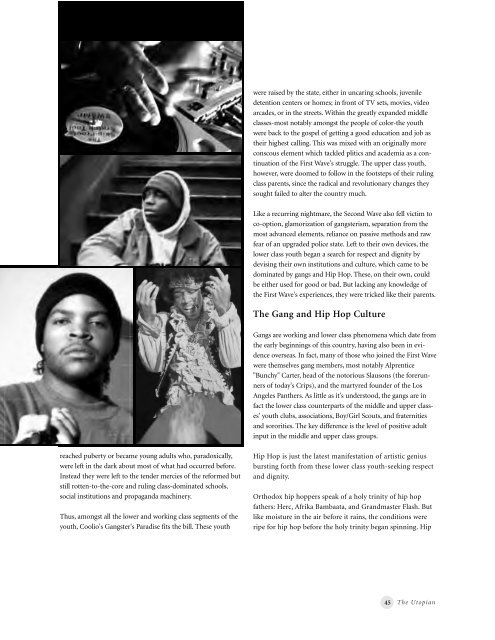MXGM Self-Defence Manual
MXGM Self-Defence Manual
MXGM Self-Defence Manual
You also want an ePaper? Increase the reach of your titles
YUMPU automatically turns print PDFs into web optimized ePapers that Google loves.
were raised by the state, either in uncaring schools, juvenile<br />
detention centers or homes; in front of TV sets, movies, video<br />
arcades, or in the streets. Within the greatly expanded middle<br />
classes-most notably amongst the people of color-the youth<br />
were back to the gospel of getting a good education and job as<br />
their highest calling. This was mixed with an originally more<br />
conscous element which tackled plitics and academia as a continuation<br />
of the First Wave's struggle. The upper class youth,<br />
however, were doomed to follow in the footsteps of their ruling<br />
class parents, since the radical and revolutionary changes they<br />
sought failed to alter the country much.<br />
Like a recurring nightmare, the Second Wave also fell victim to<br />
co-option, glamorization of gangsterism, separation from the<br />
most advanced elements, reliance on passive methods and raw<br />
fear of an upgraded police state. Left to their own devices, the<br />
lower class youth began a search for respect and dignity by<br />
devising their own institutions and culture, which came to be<br />
dominated by gangs and Hip Hop. These, on their own, could<br />
be either used for good or bad. But lacking any knowledge of<br />
the First Wave's experiences, they were tricked like their parents.<br />
The Gang and Hip Hop Culture<br />
Gangs are working and lower class phenomena which date from<br />
the early beginnings of this country, having also been in evidence<br />
overseas. In fact, many of those who joined the First Wave<br />
were themselves gang members, most notably Alprentice<br />
"Bunchy" Carter, head of the notorious Slausons (the forerunners<br />
of today's Crips), and the martyred founder of the Los<br />
Angeles Panthers. As little as it's understood, the gangs are in<br />
fact the lower class counterparts of the middle and upper classes'<br />
youth clubs, associations, Boy/Girl Scouts, and fraternities<br />
and sororities. The key difference is the level of positive adult<br />
input in the middle and upper class groups.<br />
reached puberty or became young adults who, paradoxically,<br />
were left in the dark about most of what had occurred before.<br />
Instead they were left to the tender mercies of the reformed but<br />
still rotten-to-the-core and ruling class-dominated schools,<br />
social institutions and propaganda machinery.<br />
Thus, amongst all the lower and working class segments of the<br />
youth, Coolio's Gangster's Paradise fits the bill. These youth<br />
Hip Hop is just the latest manifestation of artistic genius<br />
bursting forth from these lower class youth-seeking respect<br />
and dignity.<br />
Orthodox hip hoppers speak of a holy trinity of hip hop<br />
fathers: Herc, Afrika Bambaata, and Grandmaster Flash. But<br />
like moisture in the air before it rains, the conditions were<br />
ripe for hip hop before the holy trinity began spinning. Hip<br />
45<br />
The Utopian


